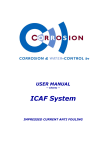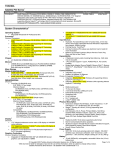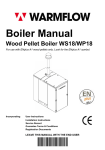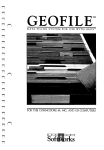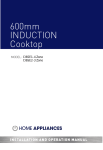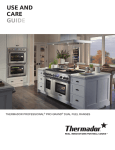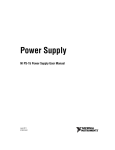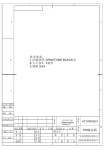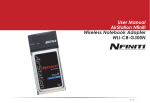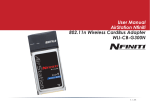Download ICCP System - MS Engineering A/S
Transcript
USER MANUAL -- Clients -- ICCP System IMPRESSED CURRENT CATHODIC PROTECTION Corrosion & Water-Control bv ICCP User manual Client 2.0 Eng. Page 2 Corros sion & Water r-Conttrol b.v v. P.O. Box 47 P NL-2750 0 AA Moe erkapellle The e Netherllands Tel. (+3 31) 79 - 5931295 5 Fax: (+3 31) 79 - 593187 71 Website e: www w.corros sion.nl Gen neral em mail : [email protected] Serrvice em mail : servic ce@corro osion.nl Corrosion & Water-Con ntrol bv ICCP User manual Client 2.0 Eng. Page P 3 Corrosion & Water-Control bv ICCP User manual Client 2.0 Eng. Page 4 Index 1. Introduction 7 1.A Remarks 7 1.B Guarantee and liability 7 1.C Environment 7 1.D Safety 7 1.E Instruction symbols 8 1.F Terms and abbreviations 8 1.G User interface 8 1.H Navigation 9 1.I Changing parameters 9 1.J Accessing parameters 10 1.K Menu flow diagram 11 1.L Main menu tabs 11 1.M Menu overview 12 2. Status Menu 13 3. Menu Unit 15 4. Menu System/settings 17 5. Menu System/Log 17 6. Menu System/SD 19 7. Menu (?)/Login 21 8. Menu (?)/Info 22 9. Menu (?)/About 23 10. Menu (?)/Activation 24 11. Understanding the hardware 25 12. Understanding the software 26 Corrosion & Water-Control bv ICCP User manual Client 2.0 Eng. Page 5 Corrosion & Water-Control bv ICCP User manual Client 2.0 Eng. Page 6 1. Introduction 1.A Remarks * Read this instruction manual before proceeding. Please note that on request of Corrosion & Water-Control bv, or any of its official worldwide agents, the installed ICCP system can be inspected prior to first use. We advice you to check with Corrosion & Water-Control bv for more information regarding the commissioning. 1.B Guarantee and liability The “General conditions” of Corrosion & Water-Control bv are applicable. Please also refer to the order confirmation for possible additions. Guarantee will not be lent in case of: Incorrect installation; Not following the instructions in this manual; Replacement with non-original parts. 1.C Environment The environmental laws and rules of the area where this ICCP system is installed, should always be respected and observed; The rules of the classification societies – if applicable – should be respected and observed; Always pay caution to dangerous voltages. 1.D Safety Attention : Touching some parts of this system may result in hazardous voltage shocks. The secondary voltage of the anodes (0 - 24 VDC) and current (0 – 1000A) used in this ICCP system is at such a level, that it can be hazardous to humans. Installation and maintenance must only be done with the main power disconnected and by knowledgeable and authorised personnel only. The primary voltage in the power supply can be hazardous to humans: installation and maintenance must only be done with the main power disconnected and by knowledgeable and authorised personnel only. Corrosion & Water-Control bv ICCP User manual Client 2.0 Eng. Page 7 1.E Instruction symbols Path to menu or function; Function description; Tip; Attention / Note; For more / Further information; Know before go; Menu activation bar (upper bar); Function dependable menu activation bar (lower bar). # & * 1.F Terms and abbreviations DPU ICCP Card PSU Rectifier Unit System Zn/Ag Normally Open (NO) Common (C) Normally Closed (NC) PS SB Digital Processing Unit (touch screen); Modular connection card; Power Supply Unit; Converts alternating currents (AC) to direct currents (DC); Collection of hardware defined as set; Complete ICCP system; Zinc / Silver alloy; State of contacts when de-energized; Contact for NO and NC; State of contacts when energized; Port side; Starboard. 1.G User interface (1) (2) (3) (4) (5) (6) (7) (8) (9) (10) : : : : : : : : : : Main menu bar; toggles between main menu and current screen; Main menu tabs; Submenu (if applicable); Active position in the submenu; Active position in the main menu; Title bar, current page/unit, total available pages/units; Display with chosen options or relevant information; Page / Unit back; Page / Unit forward; In certain menu’s the lower bar toggles an extra function. Corrosion & Water-Control bv ICCP User manual Client 2.0 Eng. Page 8 1.H Navigation Touch the main menu bar (1) to display the (main)menu tabs. The main menu bar is shown on the upper side of the lcd screen. Touch the main menu bar (1) again to hide the menu (toggle function) or choose a tab (2); If there are no sub menu’s, it will lead directly to the related menu (7); If more sub menu’s exist, then these will be displayed at the left side on the lcd screen (3); Choose a sub menu item (3). * If the lcd backlight is not activated (sleep mode), the first random touch at the screen will lit the backlight. & The current location in the menu is recognizable by the inverted (dark) tabs when menu is displayed (4 & 5). 1.I Changing parameters Select a parameter value displayed on the screen; A keypad or a choose panel will appear (current value is displayed); Enter a new value (left) or Select with “<” or “>” the proper function; confirm the new setting by pressing enter ( ) or use escape if the setting will not be confirmed (esc); Enter or escape will return to the previous menu. * Before changing the symbol (+/-), first enter the digits; & Use the delete (Å) to erase the last digit or the escape (esc) to go back without changing the parameter. Corrosion & Water-Control bv ICCP User manual Client 2.0 Eng. Page 9 1.J Accessing parameters (?), (logon) of (Logout)” The operation of this ICCP unit is categorized into four different USER levels: Level 0: read-out only, no system adjustments can be made; (Accessible for everyone); Level 1: primary functions; to access this level a pin code is needed (Ships engineers); If system adjustments must be made, a pin code is required to access the specific menu. First touch the (?) then “login”, the following keypad will appear. Enter the correct pin code followed by enter: Default pin code for level 1 = 1234; * Only when the correct password is entered, the advanced function tabs will appear; * After 15 minutes of no activity on the touch screen, the system will automatically log out and return to level 0; * To access other levels, first log out, then repeat login. Corrosion & Water-Control bv ICCP User manual Client 2.0 Eng. Page 10 1.K Menu flow diagram 1.L Main menu tabs 1 2 3 4 The main menu consist of the following items, displayed as tabs: 1. (Status) Status displays actual status and values; 2. (Unit) Unit specific settings of current shown unit*; 3. (System) General system settings; 4. (?) Logon/log off, product & customer information. * Use the backward and forward arrows to select the unit in the status screen; 1.0.1.0) Status display. Corrosion & Water-Control bv ICCP User manual Client 2.0 Eng. Page 11 1.M Menu overview M S P L (English) Unit Min Max Default Lv 1 1 2 2 0 0 0 0 1 1 0 1 0 1 0 1 Status display Alarms Unit settings Mode UNIT NA 1 NA 7 NA 1 NA 0 0 2 0 1 2 Manual current A 2 2 2 0 0 0 1 1 1 3 4 5 setpoint Max. potential Min. potential mV mV mV 3 3 3 3 1 1 1 1 0 1 1 1 0 1 2 3 System settings Date/time Language Alarm relays date select select 3 3 0 0 Logs NA 3 4 0 0 SD 3 4 1 1 Make log NA NA NA NA 1 3 4 1 2 Export log NA NA NA NA 0 NA NA NA NA 1 Imports all settings from the SD-card 3 4 1 4 3 3 4 4 1 1 5 6 Import configuration Export configuration Import Language Reboot 5 5 5 5 5 0 1 2 3 4 0 1 1 1 1 0 0 0 0 0 Information (?) Login/Logout Info About Activation 3 4 1 3 select manual -1200/-350 limit limit auto max. current -700/150 limit limit YY/MM/DD EN Error ON NA 0 Remark Overview screen per unit Overview of alarms specific settings for current chosen/displayed unit manual 1 0 1 max depend on "max. current" ( ) -900/-150 -1200/350 -700/-350 1 1 1 silver / zinc between min. and max. silver / zinc silver / zinc HH:MM EN Error OFF n/a EN Error OFF 1 1 1 NA NA 0 general settings for all units 0 Displays most recent alarms /event logs (max.100) SD card import/export, log- and system dump Makes current situation log and collect it on the SD-card Copies the complete event/alarm log on the SDcard NA NA NA NA 0 Copies all settings on the SD-card NA NA NA NA NA NA NA NA 1 0 Imports a language file from the SD-card Reboot the system to reset or update num info info num 1 NA NA NA 999999999 NA NA NA level 0 NA NA NA 0 0 0 1 Corrosion & Water-Control bv ICCP User manual Client 2.0 Eng. Page 12 2. Status Menu 1.0.0.0) Status Display overview The following screen will appear when the system is operating properly and no alarms are active. 1.0.1.0) Status display (status) 1 2 3 4 5 6 7 8 (1) (2) (3) (4) (5) (6) * 9 10 Control mode, indicates current control “Auto or Manual”; Unit number; Menu title: name of displayed menu; Current unit: Indicates current displayed units (inverted); Available units: indicates other available units if applicable; active alarms: # = ICCP card address? (G = global alarm); = total number of active alarms. Selecting the alarm column navigates to an extended information screen; Alarms & alarm settings. Corrosion & Water-Control bv ICCP User manual Client 2.0 Eng. Page 13 (7) Rectifier: Actual total current (A) and voltage (V) which is running via the anodes; Temperature: Indicates actual temperatures of the cabinet, heat sink and rectifier; Grounding: This value shows the potential difference of the propeller/shaft and indicates if the necessary grounding is functioning well. shaft grounding; (8) * When using multiple rectifiers or cabinets, the highest temperature is shown. (9) (10) On potential SB/PS: This is the actual potential level of the vessel, measured when the ICCP anodes are active and are disturbing the reference electrodes; Off potential SB/PS: This is the actual potential level of the vessel, measured when the ICCP anodes are temporary inactive, so called “Off Potential”. * Use the backward and forward arrows to select unit; * Control mode, rectifier info and potential values are specific per unit while shaft grounding and alarms are general for complete system. unit. Corrosion & Water-Control bv ICCP User manual Client 2.0 Eng. Page 14 3. Menu Unit 2.0.0.0) Unit settings Display overview * Attention : These functions should be set per unit. unit 2.0.1.1) Mode (Unit settings), “Mode” # Control mode; manual of auto Manual Auto : Static current. The running current is not determined by the measured potential. Fixed value. : Automatic Control. The running current is determined by the measured potential. This is standard for daily operation. * The static current in manual mode is set by the option 2.0.1.2 Manual current; * Attention : In manual mode the system will provide the chosen current output continuously, regardless of the actual hull potential; * Attention: Initials settings (defaults) or changing the hardware configuration settings will always set the mode to “Manual”, 0 Ampere. Control modes. 2.0.1.2) Manual current (Unit settings), “Manual current” # sets static current used in manual mode * The system prevents a setting above the system configuration; * Alarm monitoring will be still active in manual mode; * Attention : In manual mode the system will provide the chosen current output continuously, regardless of the actual hull potential. * Attention: Initials settings (defaults) or changing the hardware configuration settings will always set the mode to “Manual”, 0 Ampere. Corrosion & Water-Control bv ICCP User manual Client 2.0 Eng. Page 15 2.0.1.3) setpoint (Unit settings), “setpoint” # adjustment of the target potential (used in auto mode ) * Attention: Be aware of correct entry of the positive/negative symbol. 2.0.1.4) Max potential (Unit), “Max. potential” # adjustment of the maximum allowable potential. * Attention: Be aware of correct entry of the positive/negative symbol; * Exceeding will generate an alarm, unless related alarm monitor function is disabled; Alarms & alarm settings. 2.0.1.5) Min potential (Unit), “Min.potential” # adjustment of the maximum allowable potential. * Attention : Be aware of correct entry of the positive/negative symbol; * Exceeding will generate an alarm, unless related alarm monitor function is disabled; Alarms & alarm settings. Corrosion & Water-Control bv ICCP User manual Client 2.0 Eng. Page 16 4. Menu System/settings 3.1.0.0) Settings Display overview * Parameters are used general for all the units within the system unit. 3.1.1.1) Date/time (Settings), “Date/time” # Adjustment of date and time * Attention : The timestamp of previous made logs will not be changed; * Standard time is set according to UTC. 3.1.1.2) Language (Settings), “Language” # Change language English = Default 2nd language = import from SD card * Default: Only English language available; * Special languages on request; SD Card. 3.1.1.3) Alarm relay (Settings), “Alarm relays” # Select energized or de-energized relays in case of alarm Error on = energized while alarm is active Error off = de-energized while alarm is active * Setting applies for both relays (2x); Alarms & alarm settings. 5. Menu System/Log Corrosion & Water-Control bv ICCP User manual Client 2.0 Eng. Page 17 3.3.0.0) Logs Display overview 3.3.1.0) events & alarm logs (Logs) # displays the last 100 alarms and events (starts with most recent log) * Use the backward and forward key to navigate trough the pages; * For additional log info, copy the log to the sd card (3.4.1.0-SD card options) and use the log viewer; * Overview is filtered, for additional log info copy the log to the sd card and use the log viewer; & Touch the (lower) menu bar to clear the log. Example: 07/12/31 13:48 | ÇU01.09 07/12/31 13:48 | Ç Time stamp separator start/end alarm U source of alarm : YY/MM/DD UU:MM Ç = Start alarm È = End alarm U = Unit G = General Indicates the number of the unit where the events occurred. See table below. 01 unit number : : : : : 09 alarm code : Table alarm code Code Error/warning U/G Description 01 Max potential SB (unit) exceeding maximal potential at starboard 02 Max potential PS (unit) exceeding maximal potential at port side 03 Min potential SB (unit) below minimal potential at starboard 04 Min potential PS (unit) below minimal potential at port side 05 Anode current (unit) exceeding maximal current (A) 06 Max. voltage (unit) exceeding maximal voltage (V) 07 Shaft grounding (global) Improper or warn out shaft grounding 08 Temperature (unit) rectifier overheated 09 Temperature low (unit) Temperature sensor failure or temperature below range 10 Communication error (global) communication problem between DPU and one or more cards 11 Pot. Measurements out of range (unit) sensor failure (ICCP Card) 12 Current low/LEM signal error (unit) Current sensor or rectifier failure Corrosion & Water-Control bv ICCP User manual Client 2.0 Eng. Page 18 6. Menu System/SD 3.4.0.0) SD Display overview 3.4.1.1) make instantly a system log (level 1) (SD), “make log” # touching the button will make a log instantly * Log is made in internal memory, use 3.4.1.2) export log for export to SD card. & When inserting a SD-card, the SD main menu will automatically appear. 3.4.1.2) export log (SD), “export log” # export the internal log files on SD card * Filename is the “serial number” of the DPU unit with “CWL” extension, e.g. 1234.cwl; * Exporting the log will NOT clear the log; * If no SD card is found, the message “please insert SD-card” will appear; & When inserting a SD-card, the SD main menu will automatically appear. 3.4.1.3) Import a configuration file (level 1) (Unit), (SD), “Import cnf.” # Import a configuration file from SD card with settings (serial number. * Insert an SD card containing the correct configuration file. This files should consist a name equal with the serial number of the DPU and have a .CWS extension; * Be sure that the SD card not contains an update file (AT1440.alf); * After successful import of the file, the system will reboot automatically; * If no SD card is found, the message “please insert SD-card” will appear; * The log will be cleared after importing new settings! Corrosion & Water-Control bv ICCP User manual Client 2.0 Eng. Page 19 & When inserting a SD-card, the SD main menu will automatically appear. 3.4.1.4) Export a configuration file (Unit), (SD), “Export cnf.” # export (copy) all the settings and configuration parameters of the system on a SD card * Filename is the “serial number” of the DPU unit with “CWS” extension, e.g. 1234.cws; * If no SD card is found, the message “please insert SD-card” will appear; & When inserting a SD-card, the SD main menu will automatically appear. 3.4.1.5) Import second language file (level 1) (Unit), (SD), “Import lng” # Import a predefined language file form SD to the DPU * Insert an SD card containing the correct language file. This files should consist a name equal with the serial number of the DPU and have a.cwt extension; * After successful import of the file, the system will switch to the second language automatically; * If no SD card is found, the message “please insert SD-card” will appear; & When inserting a SD-card, the SD main menu will automatically appear. 3.4.1.6) Reboot (Unit), (SD), “Reboot” # reboot the system without the need to power down * This option can also be used to trigger an update while system is powered: Slide the SD card (containing a newest version file) into the slot, the SD functions will popup and choose reboot. & It is strongly recommended to export configurations before make any updates. Corrosion & Water-Control bv ICCP User manual Client 2.0 Eng. Page 20 7. Menu (?)/Login 5.1.0.0) Login & Logout Display overview 5.1.1.0) Login/logoff (?), (login) or (Logout)” # Login to excess level specific functions * After 15 minutes of no activity on the touch screen, the system will automatically log off. * To access other levels, first log out, then repeat login; * Default pin code for level 1 = 1234; Corrosion & Water-Control bv ICCP User manual Client 2.0 Eng. Page 21 8. Menu (?)/Info 5.1.2.0) Info Display overview 5.1.2.0) Info (?), (Info) # Serial number & version information Corrosion & Water-Control bv ICCP User manual Client 2.0 Eng. Page 22 9. Menu (?)/About 5.1.3.0) About Display overview 5.1.3.0) About (?), (about) # costumer & system information Corrosion & Water-Control bv ICCP User manual Client 2.0 Eng. Page 23 10. Menu (?)/Activation The system is carefully designed to guarantee its function between two dry-dock periods, with almost no maintenance. The lifetime of the anodes is based on the information given by the shipyard or ship owner. The almost complete dissolved anodes should be changed during a dry-dock period, with original spare anodes only. After commissioning the ICAF system should by activated with a special key, which can be obtained by internet. The expire date of this code is equal to a dry-dock period (lifetime of the anodes), plus a safety margin. Before expiration, the system will generate a pre-alarm and show the remaining lifetime of the anodes, thus before maintenance is required. The set point of this pre-alarm is set to assure plenty of time to schedule maintenance and arrange the necessary original (spare) parts. The system will repeat the pre-alarm a few times. After installation of the original anodes, the system should by activated again with a special code, which can be obtained by internet. To avoid any damage on the vessel, the system will shut down completely. To • • • • view the remaining period or to enter a new activation key: login to level 1 Proceed to the activation menu The screen shows the original period (current activation time) and the remaining time. • • To obtain an activation code, note the serial number of the DPU (Snr.) and the system code (Sys.code). Visit the website of Corrosion & Water Control bv (www.corrosion.nl), to fill in above mentioned numbers to obtain the activation key. Touch the “enter activation key” and enter the new activation key. The system is now activated and ready to use. * Attention; A locked DPU can only be unlocked with a valid activation key! * After entering a new activation code, the remaining time will be overruled. The new entered period will start immediately. • When the system is activated you are able to make use of our worldwide service network. All service engineers have easy access to all relevant details of the system when activated, so fast and determined action can be taken when required. With this feature we try to reduce the installation of non-original parts, which can affect the function of our system. Corrosion & Water-Control bv ICCP User manual Client 2.0 Eng. Page 24 11. Understanding the hardware DPU The DPU (digital processor unit) consists of a LCD display with a touch screen and microprocessor controller. This DPU is capable to control max. 4 independent ICCP units, all collaborating if required, but with individual settings and controlling specifications. Physically the ICCP units can be set up with distances up to 1000 meter (3280 feet) from the DPU. The DPU software provides a fully automatic control and provides all the information and functions, which makes it capable to meet nearly an infinity of requirements and configurations suitable for any size of vessel structures in any situation. The DPU can be installed in one of the unit cabinets or separate (e.g. control room). Units Splitting the ICCP system in two or more units might be useful: • On large vessels; • When more reference cells are preferred; • When the anode cables are too long and the voltage drop of these cables are to high; • When on large vessels installation costs are interesting. Each system, at least, consists of: • 2 Reference electrodes for measuring the potentials of the structure; • 2 Anodes; • One or more rectifiers to generate the current needed for the anodes; • One or more ICCP cards*, depending on the number of rectifiers and/or shafts grounding to be monitored. * Each ICCP card equipped with 2 PSU outputs to connect the rectifiers and 2 shaft sensor inputs. Corrosion & Water-Control bv ICCP User manual Client 2.0 Eng. Page 25 12. Understanding the software Control modes The system can be set in the automatic or manual operation mode. In normal situations the system will run in Auto-mode. The following indicators are shown on the status display when active: (auto) (manual) (off request) (powerboost) : : : : Auto potential control, power on; Manual mode; fixed current control; Off potential measurement in progress; ICCP fresh water purposes. Auto control The ICCP system consists of a fully automatic potential control algorithm, to always keep the structure in the optimal potential range regardless of changing environmental parameters. Besides controlling, the system will monitor and log all exceeding limits and control the functioning of the hardware. The status screen (1.0.0.0) shows the actual information in a glance. Daily there will be made one or more data log(s) in order to always have a complete history of the performance available. Functions related to automatic control; 2.0.1.1) Mode toggles between auto control and manual control. 2.0.1.3) Setpoint sets the target potential during auto control. * Attention: Initials settings (defaults) or changing the hardware configuration settings will always set the mode to “Manual”, 0 Ampere. Manual operation Manual operation mode is only reserved for testing the system performance, or as a temporary backup system in case the automatic system fails. The manual control will provide the chosen current output regardless of the actual hull potential. Use this manual operation only after consulting Corrosion & Water-Control bv. Increase the required current by steps of 0.5 Amperes until the potential difference is set to -800 mV to – 900mV. In the first 12 hours, check the potential difference every hour for the potential differences. After 12 hours it is recommended to check the potential difference once a day. * Set manual current back to 0 Ampere when switching back to Auto mode. Functions related to manual control; 2.0.1.1) Mode toggles between auto control and manual control. 2.0.1.2) Manual current sets the fixed amount amperes during manual control. Corrosion & Water-Control bv ICCP User manual Client 2.0 Eng. Page 26 Off potential The system is also capable of measuring the actual potential level, of the stucture, without the interference of the ICCP anodes. These “off potentials” measurements are done by the reference cells when all anodes of the complete ICCP system are temporary de-activated. * It is recommended to disable this “off value” function on naval vessels or vessels executed with high sensitive measuring equipment/sensors on the outside hull (underwater part). blast function The blast function is intended for a short blast of high current generated by the anodes. In case of long duration/operation times in fresh waters. * Use with utmost care, in any doubt contact Corrosion & Water-Control or your local agent. shaft grounding The potential of maximum 3 shafts can be reflected and monitored by the ICCP system. Every ICCP card offers space for 2 connections. Through the menu it can be simply indicated which input is connected. The shaft potential is monitored continuously and an alarm will be generated when exceeding the maximal allowed potential, measured in mV. Alarms & alarm settings Functions related to shaft monitoring; 3.2.1.2) Max. Shaft Sets alarm limit in mV for all shafts. Corrosion & Water-Control bv ICCP User manual Client 2.0 Eng. Page 27 Alarms & alarm settings The ICCP system is provided with an extensive monitor & alarming features. Alarms will be generated when preset values or limits are exceeded. * The ICCP system provides enough memory to log at least 15000 alarms and events. * Use function 3.3.0.0 Logs to view the previous 100 alarms. If an alarm is generated, the following actions will take place: • The alarm code will be clearly shown in the display alarm codes; • The system will log the alarm, including relevant information alarm & Event logging; • The alarm relays will be activated alarm relays. * All • • • Alarms should be acknowledged. alarms (except system errors) are individual provided with: Adjustable upper and/or lower limits; Adjustable delay time to avoid unnecessary alarms; Special options. “Off” is not used. It is possible that an alarm is generated when the system is taken into first use. This is a normal situation; accept the alarm by pressing the “accept” button. The alarm will disappear within 24 hours. If the alarm continuous for more than 48 hours please contact the engineers of Corrosion & Water-Control bv. Functions related to system monitoring Limits 2.0.1.4) Max. potential sets maximal allowable potential 2.0.1.5) Min. potential sets minimal allowable potential alarm codes The log screen displays the last 100 alarm records, sorted by date. All lines starts with a timestamp followed by a code. This code represents the following information: Example : 07/12/31 13:48 | ÇU01.09 07/12/31 13:48 | Ç Time stamp separator start/end alarm U source of alarm 01 09 unit number alarm code Corrosion & Water-Control bv ICCP User manual Client 2.0 Eng. : YY/MM/DD UU:MM : : : : : : Ç = start alarm È = end alarm U = unit G = general only in case of unit see table alarm code Page 28 Table alarm code Code Error/warning U/G Description 01 Max potential SB (unit) exceeding maximal potential at starboard 02 Max potential PS (unit) exceeding maximal potential at port side 03 Min potential SB (unit) below minimal potential at starboard 04 Min potential PS (unit) below minimal potential at port side 05 Anode current (unit) exceeding maximal current (A) 06 Max. voltage (unit) exceeding maximal voltage (V) 07 Shaft grounding (global) Improper or warn out shaft grounding 08 Temperature (unit) rectifier overheated 09 Temperature low (unit) Temperature sensor failure or temperature below range 10 Communication error (global) communication problem between DPU and one or more cards 11 Pot. Measurements out of range (unit) sensor failure (ICCP Card) 12 Current low/LEM signal error (unit) Current sensor or rectifier failure alarm relays The system includes two double poled relays for respectively alarm notification to third party equipment and indication of the system status. Both relays will be activated whenever an alarm occurs. The first relay will be de-activated after acknowledgement, while the second relay stays active as long as the alarm situation remains. The function 3.1.1.3) alarm relays provides the choice whether, the relays should be energized (normally de-energized) or vice versa. Together with both normally open or closed hardware connections available, a variety of function can be made, depended on the requirement. While an alarm is not (yet) acknowledged, the first relays will stay active. In order to be notified of other alarms. * “normally open” and “normally closed” contacts are in perspective of a de-energized relays. The recommended connection is a de-energized relays connected to the normally open contacts. In order to have a “fail safe” alarm which will set the alarm in case of power interruption or broken wires. Functions of the alarm relays: 3.1.1.3) alarm relays Defines energized or de-energized relays function during alarm. For a complete understanding of the alarm behaviour, we refer to the following schematic overview; Corrosion & Water-Control bv ICCP User manual Client 2.0 Eng. Page 29 Event & alarm logging The DPU is equipped with a flash memory which offers space for 15000 alarm, events or data logs. The internal flash mechanism is bases on FI-FO (First In - First Out) e.g. after complete filling of the memory the oldest log will be replaced by any new one. There are 4 types of logs: • Data logs : general daily log of the performance of the ICCP system; • Alarm logs : error code including time stamp and source of the alarm; System log : system dump of current hard and software situation, especially for debug hard & software purposes; • Event logs : to monitor changes at the system like start-up. * The last 100 alarm logs (including startup event log) can be displayed in the display provided with timestamp 3.3.0.0 Logs). * Clearing the alarms in the display will not delete the logs in the flash memory. * To copy logs onto a SD card SD Card Corrosion & Water-Control bv ICCP User manual Client 2.0 Eng. Page 30 SD Card The back of the DPU is provided with a SD-card slot. The SD card is used for update the system and import/export data form and into the system. * The SD card must be formatted with a FAT (not FAT32) system. This can be achieved by any computer with a Windows™ operating system with a SD card slot. Import/export data When sliding a SD Card in the slot, while the system is powered, the DPU will automatically detect the presents and trigger the SD card menu (3.4.0.0) This menu shows the following options: Make log : instantly make a system dump (internal memory!) Export Log : copies the TOTAL log (including a system dump) on SD card. Import language : import a second language from sd card (future option) Update the ICCP To update the ICCP system; • Copy the update file (xxx.alf file) on to the SD card. • be sure the system is unpowered. • Slide the SD card into the slot • Power the system • The screen shows the status of the update import and will start automatically after finishing the update. (don’t interrupt this process!) • Check the settings and adjust were needed. * Attention : In case of new release with additional functions, parameters and configurations will be set as factory defaults. Be sure to have a backup of all the settings and configurations and the knowledge to adjust these. Corrosion & Water-Control bv ICCP User manual Client 2.0 Eng. Page 31































